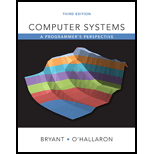
Concept explainers
A.
Explanation of Solution
Explanation:
The above diagram describes about th...
B.
Deadlock:
In a computer system, a set of blocked processes each holding a resource and waiting to acquire the resource held by another process in the set is called a deadlock problem.
Example:
Consider the savings and loan institution. In that, the savers want to withdraw the amount from their own accounts than the available amount in the institution.
- At the same time, the institution cannot force the borrowers to return the amount they borrowed from the institution.
- Now, the deadlock problem occurs in this scenario because the borrowers hold the resource (amount) that the institution has to satisfy the request of the savers.
- This deadlock problem can be resolved by arranging the required amount by the institution for the valuable customer from the other institutions.
C.
Deadlock:
In a computer system, a set of blocked processes each holding a resource and waiting to acquire the resource held by another process in the set is called a deadlock problem.
Example:
Consider the savings and loan institution. In that, the savers want to withdraw the amount from their own accounts than the available amount in the institution.
- At the same time, the institution cannot force the borrowers to return the amount they borrowed from the institution.
- Now, the deadlock problem occurs in this scenario because the borrowers hold the resource (amount) that the institution has to satisfy the request of the savers.
- This deadlock problem can be resolved by arranging the required amount by the institution for the valuable customer from the other institutions.
D.
Explanation of Solution
Explanation:
The above diagram describes about the progr...
Want to see the full answer?
Check out a sample textbook solution
Chapter 12 Solutions
Computer Systems: A Programmer's Perspective Plus Mastering Engineering With Pearson Etext -- Access Card Package (3rd Edition)
- using r language Obtain a bootstrap t confidence interval estimate for the correlation statistic in Example 8.2 (law data in bootstrap).arrow_forwardusing r language Compute a jackknife estimate of the bias and the standard error of the correlation statistic in Example 8.2.arrow_forwardusing r languagearrow_forward
- using r languagearrow_forwardThe assignment here is to write an app using a database named CIT321 with a collection named students; we will provide a CSV file of the data. You need to use Vue.js to display 2 pages. You should know that this assignment is similar, all too similar in fact, to the cars4sale2 example in the lecture notes for Vue.js 2. You should study that program first. If you figure out cars4sale2, then program 6 will be extremely straightforward. It is not my intent do drop a ton of new material here in the last few days of class. The database contains 51 documents. The first rows of the CSV file look like this: sid last_name 1 Astaire first_name Humphrey CIT major hrs_attempted gpa_points 10 34 2 Bacall Katharine EET 40 128 3 Bergman Bette EET 42 97 4 Bogart Cary CIT 11 33 5 Brando James WEB 59 183 6 Cagney Marlon CIT 13 40 GPA is calculated as gpa_points divided by hrs_attempted. GPA points would have been arrived at by adding 4 points for each credit hour of A, 3 points for each credit hour of…arrow_forwardI need help to solve the following case, thank youarrow_forward
 Systems ArchitectureComputer ScienceISBN:9781305080195Author:Stephen D. BurdPublisher:Cengage LearningProgramming Logic & Design ComprehensiveComputer ScienceISBN:9781337669405Author:FARRELLPublisher:Cengage
Systems ArchitectureComputer ScienceISBN:9781305080195Author:Stephen D. BurdPublisher:Cengage LearningProgramming Logic & Design ComprehensiveComputer ScienceISBN:9781337669405Author:FARRELLPublisher:Cengage C++ Programming: From Problem Analysis to Program...Computer ScienceISBN:9781337102087Author:D. S. MalikPublisher:Cengage Learning
C++ Programming: From Problem Analysis to Program...Computer ScienceISBN:9781337102087Author:D. S. MalikPublisher:Cengage Learning EBK JAVA PROGRAMMINGComputer ScienceISBN:9781337671385Author:FARRELLPublisher:CENGAGE LEARNING - CONSIGNMENTNp Ms Office 365/Excel 2016 I NtermedComputer ScienceISBN:9781337508841Author:CareyPublisher:Cengage
EBK JAVA PROGRAMMINGComputer ScienceISBN:9781337671385Author:FARRELLPublisher:CENGAGE LEARNING - CONSIGNMENTNp Ms Office 365/Excel 2016 I NtermedComputer ScienceISBN:9781337508841Author:CareyPublisher:Cengage





